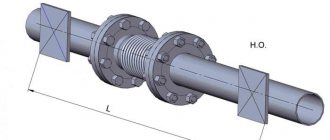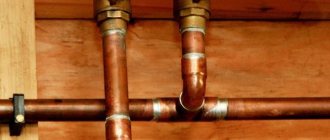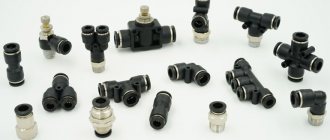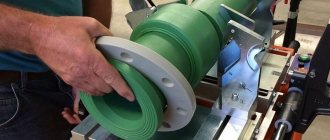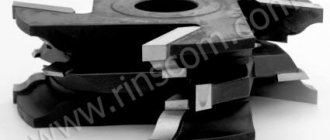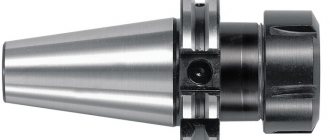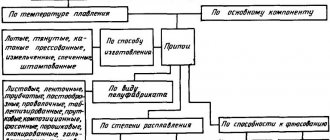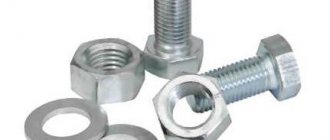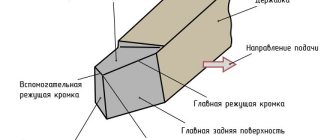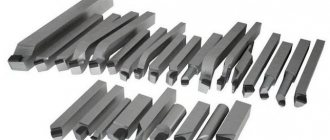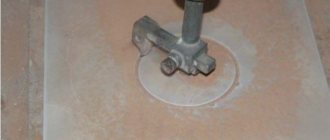To transport gases, liquids, and solids, a complex engineering pipeline system has been created, including pipes and various types of connections. Under the influence of pressure or landscape-geodetic environment, materials move through pipes to their destination. There are a large number of types of pipes for water supply, sewerage, heating and other systems. Here are several common classifications based on the characteristics of the equipment.
GOST 32569-2013 - requirements for the design and operation of pipelines
Types of pipeline by type of material
Depending on the type of material being transported, the following pipelines exist:
- Gas pipeline - for gas transportation. A main pipeline has been created to transport gas fuel over long distances. Along the entire line there are compressor stations that maintain constant pressure in the network. At the final path of the gas pipeline, distribution stations reduce the pressure to the levels required for supply to consumers.
- Oil pipeline - designed to transport oil and refined products. There are field, main, connecting and distribution types of pipelines. Depending on the petroleum product being transported, there are: fuel oil pipelines, gasoline pipelines, kerosene pipelines. The main pipeline is represented by a system of underground, surface, underwater and overground communications.
- Hydraulic drive - for transporting minerals. Bulk and solid substances are transported under the influence of water flow. In this way, coal, gravel and sand are transported over long distances from deposits to consumers and waste is removed from power plants and processing plants.
- Water supply is a type of pipe for drinking and technical water supply. Hot and cold water moves through underground pipes to water towers, from where it is supplied to consumers.
- Water outlet is a system for draining water accumulating in the lower parts of collectors and tunnels.
- A drain is a network of pipes for draining storm and groundwater. Designed to improve soil condition during construction work.
- Air duct - used to move air in ventilation and air conditioning systems.
- Sewerage is a type of pipeline for removing waste products and household waste. There is also a sewer system for laying cables underground.
- Steam pipeline - for steam transmission at thermal and nuclear power plants, industrial enterprises.
- Heat pipeline - for supplying steam and hot water to heating systems.
- Oxygen pipelines - for supplying oxygen at industrial enterprises, intra-shop and inter-shop pipelines are used.
- Ammonia pipeline is a type designed for pumping ammonia.
Cross-linked polyethylene
A more reliable and durable pipeline system that replaced metal-plastic. Appeared in the mid-2000s and was represented mainly by German brands. As it spread, the geography of production expanded and currently there are manufacturers on the market from Italy, Spain, the Czech Republic, Sweden, Poland, Turkey, Russia and China. There are three main types of cross-linked polyethylene - PE-Xa, PE-Xc and PE-Xb. For heating and water supply systems, either a simple or aluminum-reinforced polyethylene pipe is used; for water heated floors, a polyethylene pipe with an oxygen barrier is used. The most expensive and high-quality type is considered to be PE-Xa, the average is PE-Xc, the most budgetary is PE-Xb. PE-Xa and PE-Xc - used mainly in heating and water supply systems, PE-Xb - in water heated floor systems. For open wiring, pipes with a reinforcing layer are used, since they hold their shape when heated and have virtually no linear elongation. Pipes without reinforcement, on the contrary, are used for hidden wiring (in floors, walls, etc.), due to the fact that when heated, sagging and large linear elongation of the pipe are possible. There are two types of pipe connections - axial pressing with a sliding sleeve and a Eurocone collet connection. Eurocone is used mainly for connecting pipes to collector bends and radiator shut-off valves, while pressing allows pipes to be connected anywhere. Fittings are usually made from brass or special plastic (polyphenylsulfone) and have a very wide range. To install pipes of the axial pressing system, a special tool is required, including a pipe expander and pressing pliers.
Pipeline classification
Pipelines, depending on the hazard class of the transported substance (explosion, fire hazard and harmfulness) are divided into environmental groups (A, B, C) and, depending on the calculated parameters of the environment (pressure and temperature) - into five categories (I, II, III, IV, V).
The designation of a group of a certain transported medium contains the designation of the group of the medium (A, B, C) and the subgroup (a, b, c), reflecting the toxicity and fire and explosion hazard of the substances included in this medium.
| Environment group | Transport is my substance | Pipeline category | |||||||||
| I | II | III | IV | V | |||||||
| , MPa | , °С | , MPa | , °С | , MPa | , °С | , MPa | , °С | , MPa | , °С | ||
| A | Substances with toxic effects GOST 12.1.007 | — | — | — | — | — | — | — | — | — | — |
| a) extremely dangerous substances of class 1, highly dangerous substances of class 2 | Regardless | Regardless | — | — | — | — | — | — | — | — | |
| b) moderately hazardous substances of class 3 | St. 2.5 | St. plus 300 or below minus 40 | From vacuum 0.08 to 2.5 | From minus 40 to 300 | — | — | — | — | — | — | |
| Vacuum below 0.08 | Regardless | ||||||||||
| B | Explosion and fire hazardous substances GOST 12.1.044 | — | — | — | — | — | — | — | — | — | — |
| a) flammable gases (GG), including liquefied hydrocarbon gases (LPG) | St. 2.5 | St. plus 300 or below minus 40 | From vacuum 0.08 to 2.5 | From minus 40 to 300 | — | — | — | — | — | — | |
| Vacuum 0.08 and higher | Regardless | ||||||||||
| — | — | — | — | ||||||||
| b) flammable liquids (flammable liquids) | St. 2.5 | St. plus 300 or below minus 40 | St. 1.6 to 2.5 | Up to 300 | Up to 1.6 | From minus 40 to 120 | — | — | — | — | |
| Vacuum below 0.08 | Regardless | Vacuum above 0.08 | From minus 40 to 300 | — | — | — | — | ||||
| c) flammable liquids (FL) | St. 6.3 | St. plus 350 or below minus 40 | St. 2.5 to 6.3 | Up to 350 | St. 1.6 to 2.5 | Up to 250 | Up to 1.6 | From minus 40 to 120 | — | — | |
| Vacuum below 0.003 | From 0.003 vacuum to 0.08 vacuum | Vacuum above 0.08 | From minus 40 to 250 | — | — | ||||||
| IN | Low-flammable (TG) and non-flammable (NG) substances | Vacuum below 0.003 | St. plus 450 or below minus 60 | From 0.003 vacuum to 0.08 vacuum or up to 6.3 | Up to 450 | St. 2.5 to 6.3 | Up to 350 | St. 1.6 to 2.5 | Up to 250 | From vacuum 0.08 to 1.6 | From minus 40 to 120 |
| St. 6.3 | From vacuum 0.08 to 1.6 | Below minus 40 | |||||||||
Pipelines are classified according to various criteria:
- Material. Since increased strength requirements are imposed on pipes, they are made from reliable materials: carbon and alloy steel, titanium, cast iron, aluminum, copper. Steel and metal-plastic pipes are powder coated. Polypropylene pipes are widely used in water supply systems.
- Ability to withstand temperature loads. It is important because the transported substances have different temperatures and are transmitted in different climatic conditions. Based on this criterion, pipelines are divided into: cold - below 0 degrees, medium - from 1 degree to + 45 degrees, hot - above 45 degrees;
- Scale:
- trunk - designed to transmit various substances over long distances; include a line, installations for the preparation of transferred materials, pumping and distribution stations;
- technological - used in industrial conditions; serve for transportation of fuel, raw materials, steam, hot water, gas,
- machine - used in systems with an internal combustion engine;
- municipal - for the transfer of water, heat, gas in public utilities and the removal of household waste;
- ship - for pumping liquid materials on ships.
- ground - laid above the ground, installed on beams, arches, supports;
- underground - laid below ground level in ditches and trenches;
- underwater - carried along the bottom of seas, oceans, rivers, lakes;
- floating - placed on the water surface using floats and fastenings.
Oil and petroleum products
Onshore oil pipeline in Alaska Photo: ru.wikipedia.org
The principle of creating oil pipelines was substantiated in 1863 by Dmitry Ivanovich Mendeleev, and already in 1878, the first oil pipeline 10 km long was built on the Absheron Peninsula, which went to the oil refineries of Baku from the Balakhani field.
Nowadays, about 200 thousand km of oil pipelines have been built, the champion here is Russia: more than 80 thousand km of oil pipelines are Russian.
Even more information about the types of pipes for water supply and sewerage
You can get more information about the types of pipes for water supply and sewerage from an expert.
Our specialists are familiar with all accepted classifications of pipelines and are ready to recommend suitable products for laying communications. There are pipes and connections for water supply, heating and other utility networks to choose from. You can also order installation of water supply and sewerage systems from polypropylene pipes and HDPE products from us. Order a consultation
Low pressure polyethylene (HDPE)
Under this abbreviation lies low-density polyethylene. Black plastic pipes. Purpose: cold water supply systems. It is used mainly in country houses for irrigation, supplying water from wells and boreholes, in places where everything needs to be done as inexpensively and practically as possible. For connections, plastic collet-type fittings (crimp nut) are used, less often brass ones. Manufacturers are mostly Russia, sometimes Italy and Türkiye.
Beer
In 2016, the world's first beer pipeline was built in the Belgian city of Bruges. The pipe is 3 km long. The pipe is underground and pumps 4,000 liters of beer per hour. The beer is pumped from the De Halve Maan brewery, located in the center of Bruges, to the outskirts of the city, to the industrial area, where further processing of the product takes place.
The beer pipeline brought huge profits to the brewery, because now there is no need to transport large volumes of beer through the very narrow streets of the ancient city. Now the brewery only brews beer, and the filling of bottles and kegs takes place in an industrial area on the outskirts.
Hydrogen
Recently, as part of environmental projects, “greens” have been trying to dramatically increase the production of electricity and heat by using hydrogen as fuel at thermal power plants. After all, the combustion of hydrogen does not produce harmful substances - only water. At the same time, the technology for pipeline pumping of hydrogen has already been established: in the USA, the length of hydrogen pipelines is 1,400 km, and in Europe - about 1,500 km.
The very first Rhine-Ruhr water pipeline was built in Germany in 1938, its length is 240 km. It still works today.
Brine
In Austria, in the village of Hallstatt, salt has been mined for many centuries. To transport the extracted product, a salt pipeline was built in 1595. 13,000 tree trunks were hollowed out and brine was pumped through the resulting pipe from Hallstatt to Ebensee over a distance of 40 km.
I have come across information before that there are pipelines through which sunflower oil and something else are pumped. But now I have not been able to find confirmation. I wouldn’t be surprised at the existence of some even more exotic pipelines!
Tags: modes of transport, pipeline, water supply, water supply and sewerage
Slurry lines
It is sometimes more profitable to transport ore concentrates or coal from the place of production to the port not in containers, by car or by rail, but in the form of an aqueous suspension through a pipeline. The concentrate is mixed with water and pumped through pipes to where it is needed. After pumping, the concentrate is separated from the water, the water passes through a filter system for purification, and the dried concentrate enters the port.
Sludge from ore washing, 1897. Photo: ru.wikipedia.org
In Ohio, two slurry pipelines were built in late 1950 to transport coal. In Tasmania (Australia), an 80-kilometer slurry pipeline was built in 1967 to transport iron ore.
There are two slurry pipelines in operation in India with a length of more than 250 km.
A 525 km long slurry pipeline is currently being designed in Brazil to transport iron ore concentrate.
